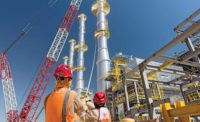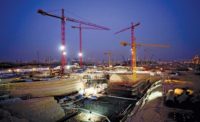Caution and cost-control remain the watchwords for engineering and construction firms working in the petroleum sector, even as November saw benchmark crude-oil prices inch above the $60-per-barrel milestone for the first time in two years.
Analysts say global crude-oil prices could jump by as much as a third over the next 12 months. But years of sustained low prices have made owners more cost-conscious, and they are closely managing their capital investments, according to Jeff Sips, principal vice president for Bechtel Oil, Gas & Chemicals. As a result, the era of the megaproject is coming to a close. “Customers want to have a better line of sight between investment and returns,” he says.
Some large projects still are being considered, such as Abu Dhabi’s plan to invest $20 billion in an offshore development project that could yield as much as 5 trillion cu ft of natural gas. For most, however, the focus is on incremental capacity increases and measures to improve efficiency, with midstream product-transfer projects and downstream petrochemical production among the most active project types.
“We’re responding by trying to rethink the overall project process and take costs out, rather than just lowering them,” Sipes says. Bechtel will have the opportunity to apply those practices in Egypt, among other countries. Carbon Holdings recently awarded the company contracts to provide project management services for the Tahrir Petrochemicals Complex, sited at Ain Sokhna, as well as build two new polypropylene units at an adjacent site.
Likewise, lower prices for natural gas have created opportunities for innovation, complementing owners’ push for contractors to bring more value to their projects. “The more cost-effective, the better,” says Deepa Poduval, a senior managing director for Black & Veatch.
One way to add value is to expedite the import-export process for natural gas. For example, floating LNG (FLNG) facilities integrate natural-gas liquefaction systems on an offshore vessel, which can be relocated as necessary.
Poduval notes that FLNG facilities offer the advantages of construction and commissioning on compressed schedules, lower capital costs and reduced environmental impact.
Black & Veatch will provide engineering, procurement and construction services for India’s first FLNG project, an import terminal, sited at Jafrabad in Gujarat, that will produce 5 million metric tons per annum (MPTA). Also, Wison Offshore & Marine is working with KBR Inc. on a 1.5-MPTA FLNG project in Papua New Guinea.
“Developing economies in Southeast Asia and South America are well suited for these types of projects,” Poduval adds, noting FLNGs’ adaptability for power-generation projects. Black & Veatch is working on a 1,500-megawatt, high-efficiency combined-cycle generating facility in Porto de Sergipe, Brazil, that will be fueled with natural gas produced from an offshore FLNG.
Further, the Asia-Pacific holds refining and petrochemical opportunities. For example, in Malaysia, Fluor is part of a joint venture working with the state-owned Petroliam Nasional Berhad on a 300,000-barrel-per-day refinery and petrochemical complex.
“We are also working on several chemical, polysilicon, LNG and oil-and-gas facilities,” adds Ken Choudhary, Fluor’s energy and chemicals president for the region. Fluor has been making significant investments in applying data analytics to improve project planning, he notes.
“It allows us to identify and mitigate potential project challenges earlier in the process, allowing our team to spend more time on analyzing and forecasting project outcomes,” Choudhary says.





Post a comment to this article
Report Abusive Comment